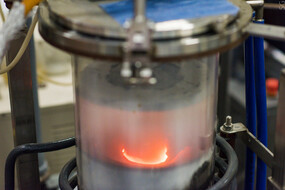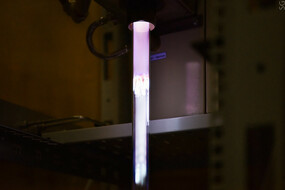The research team from NUST MISIS has presented a new catalyst based on boron nitride and iron and platinum nanoparticles, demonstrating a high degree of carbon dioxide (CO2) conversion: 25% at 350 C, which is
The increase in the concentration of greenhouse gases is one of the main reasons for the rise in the average annual temperature and a global world problem. Reducing the level of CO2 emission is one of the most pressing long-term tasks of mankind and a serious challenge for the scientific community.
Today, there are two main production methods of the catalysts for the carbon dioxide processing: using noble metals — effective, but expensive, and without them — cheaper, but with significantly reduced characteristics.
The research team of NUST MISIS proposed a compromise solution — to use inexpensive iron as a catalyst component, reducing the content of noble metals (in this case platinum) to less than 1 atomic %.
But even when implementing the proposed solution, there is a difficulty — bimetallic iron-platinum nanoparticles tend to sinter at elevated temperatures (agglomeration process). In this case, the specific surface area of the particles decreases, which negatively affects the catalytic properties.
“This is the first time we have used boron nitride as a carrier for catalytically active iron-platinum nanoparticles. One of the features of the obtained heterogeneous material is that after the synthesis the size of iron-platinum particles is only 2 nanometers. Due to their small size, these particles are very evenly distributed over the boron nitride surface. But, what is more interesting, that during the catalytic process, the size of the iron-platinum particles increases insignificantly (on average, up to 8 nanometers). We believe that this is one of the reasons the material shows high catalytic properties,” says Anton Konopatsky, Ph.D., a co-author of the work, a researcher at the NUST MISIS Inorganic Nanomaterials.
In the paper, the team has shown a unique mechanism of iron-platinum nanoparticles stabilization: thin sheets of boron nitride were wrapped around the particles at elevated temperatures. As a result, heterogeneous particles with a core-shell structure were formed and their agglomeration was significantly hindered.
“We used relatively simple method to synthesize our catalysts. One of the most important steps was to uniformly distribute the initial materials in the synthesis medium. The structure evolution of the synthesized material were observed in situ at a temperature of 500 °C using a transmission electron microscope. It allowed us to suggest what happens to the material during catalysis” adds Anton Konopatsky.
The obtained material can be used at any enterprise with massive CO2 emissions. These are oil refineries, chemical and metallurgical plants, cellulose industry, etc.
The main product of the reaction of CO2 processing using the obtained catalyst is CO (carbon monoxide), which can be reused in industrial processes. However, according to the developers, from the economic point of view, the production of complex hydrocarbons with high added value from CO is of greater interest. This will be the goal of the following research of the team.






